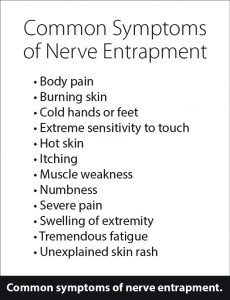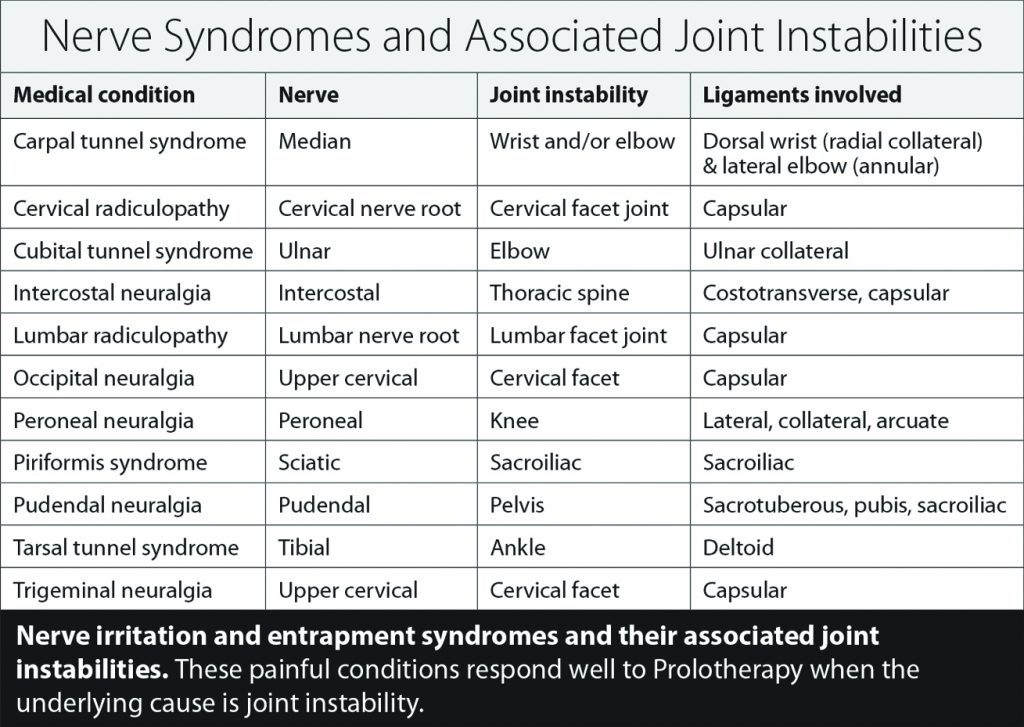Joint instability and ligament injury are almost always the missing diagnoses in chronically painful musculoskeletal conditions, even with nerve pain. As in other sensations, pain is carried by nerves to the central nervous system, ultimately to be interpreted and experienced by the brain. Nerves alert the brain to the presence of an injury or problem because they are being inflamed, entrapped, compressed by nearby bone or myofascial tissue, or encountering excessive stretch. As they zig zag through the myofascial plane between muscles and through bony tunnels, nerves are within 1-2 mm of the bone or bony prominence. When the joint is unstable, however, the bones move excessively due to ligament laxity. This can result in the nerve being irritated or compressed, and produce shooting pain, numbness, or other symptoms. (See figure 1.)

Is your pain positional?
The key indication that nerve irritation is coming from joint instability is that the symptoms are positional. For instance, pinched nerves in the neck feel better when looking down (vs. looking up) and pinched nerves in the lower back feel better when the patient sits down (vs. standing or walking). When a symptom decreases after changing position, such as by placing one’s arm or leg in a certain position, then joint instability and ligament laxity are most likely the instigating factors and need to be treated for long-term resolution. (See figure 2.)

Avoiding permanent nerve damage
When a nerve is compressed for too long, the tissues the nerve supplies can actually start to die, resulting in muscle atrophy and loss of sensation. Conditions involving large nerve compression, such as a nerve root or the sciatic nerve, need to be taken very seriously, and addressed quickly to prevent irreversible nerve damage. (See figure 3.)

Regenerative medicine physicians can determine which nerve compressions or entrapments can be treated non-surgically! The compression of the nerve can be documented with musculoskeletal ultrasound and digital motion x-ray (DMX). By viewing the nerve when the patient is in the asymptomatic position, one can see that the nerve is not being compressed or touched by any bone in that position. (See figure 4.)

Likewise, the nerve space narrows when joint instability is present, and during symptom producing positions. If symptoms are aggravated by Non-surgical and non-drug approach to nerve pain
Like ligaments, nerves can stretch to a certain degree. When a nerve becomes sensitized, meaning injured and neurogenic inflammation sets in, the nerve is no longer stretchable and will produce severe stinging pain when stretched even a little. When joint instability is the primary cause of a sensitized nerve, Prolotherapy can be given to trigger long-term ligament and soft tissue repair. Nerves are treated along with the ligaments when a person has joint instability, in an effort to speed healing. There are two primary methods of directly treating the nerves. When the nerve involved is deep and/or entrapped, ultrasound-guided Nerve Release Injection Therapy (NRIT) is used to direct natural substances to the exact nerve entrapment location. NRIT (also called hydrodissection) mechanically releases and nourishes the nerve, as well as restores homeostasis. (See figure 5.)

Because the nerve entrapment is resolved and the health of the nerve is immediately restored, the symptom-relieving effects are often felt instantly, right in the office.
When the nerve is located superficially or is larger and easy to identify, then Lyftogt Perineural Injection Treatment (LPIT) is given at the sites of nerve restriction and inflammation, to relieve the constriction and restore homeostasis to the nerve. LPIT was discovered by a family physician from New Zealand, John Lyftogt, MD, and is growing in popularity amongst doctors around the globe for its ease and effectiveness for the patient.
While traditional options are typically limited to nerve pain medications, steroids, and surgery, these can have undesired long-term consequences. The ideal treatment must address the underlying joint instability and ligament injury as well as re-nourish the nerves. (See figure 6.)

Many nerve pain conditions such as neuritis, nerve entrapments, neuralgia, or neuromas are easily treated with regenerative techniques. If a condition involves an irritated, compressed, or sensitive nerve, a simple in-office natural injection technique may restore the nerve to health as well as the tissues it innervates!
Regenerative Medicine Specialists
CaringMedical.com
239-303-4546
with locations in Fort Myers and Chicagoland







